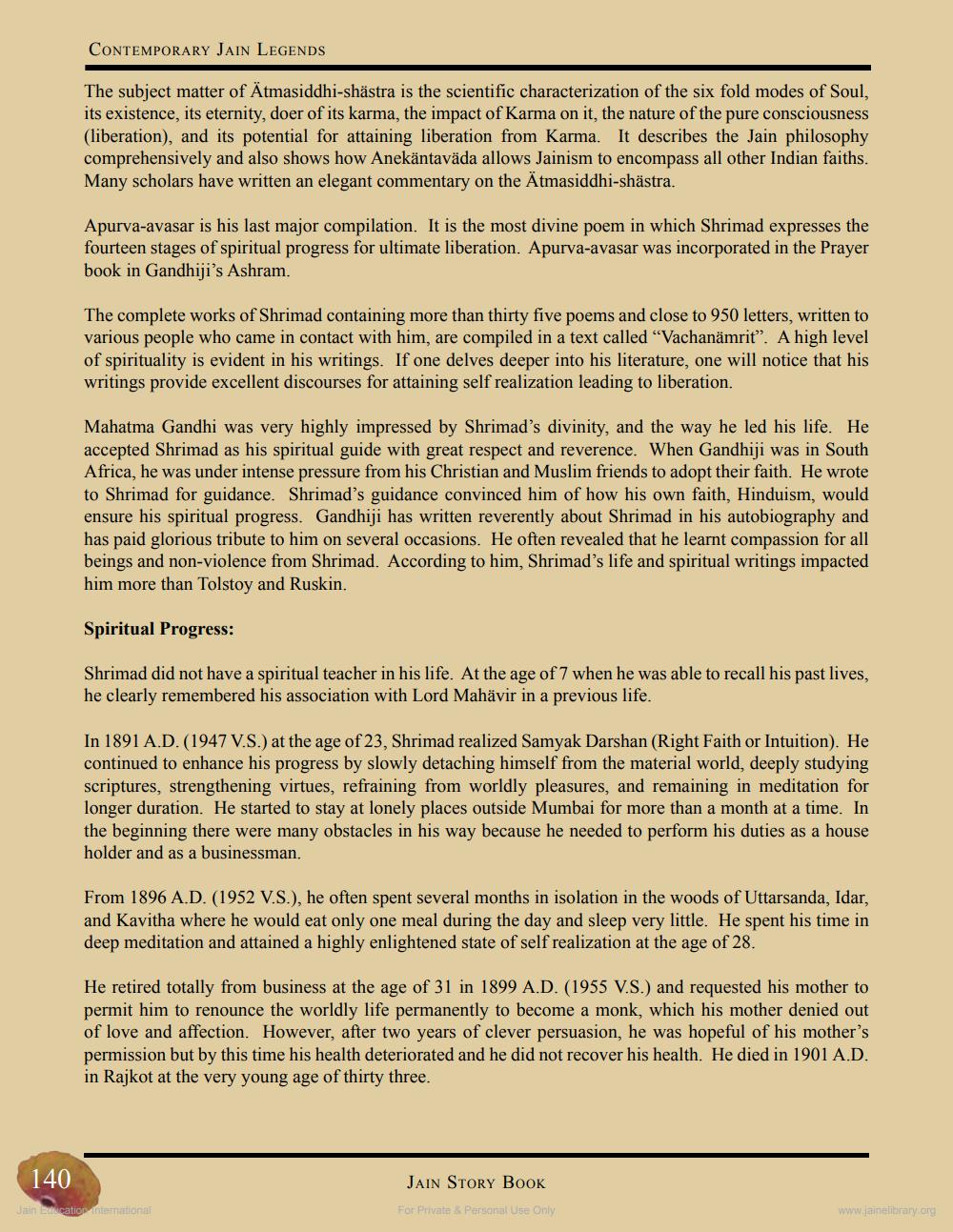Book Title: Shrimad Rajchandra Author(s): JAINA Education Committee Publisher: JAINA Education Committee View full book textPage 4
________________ CONTEMPORARY JAIN LEGENDS The subject matter of Atmasiddhi-shästra is the scientific characterization of the six fold modes of Soul, its existence, its eternity, doer of its karma, the impact of Karma on it, the nature of the pure consciousness (liberation), and its potential for attaining liberation from Karma. It describes the Jain philosophy comprehensively and also shows how Anekäntaväda allows Jainism to encompass all other Indian faiths. Many scholars have written an elegant commentary on the Atmasiddhi-shästra. Apurva-avasar is his last major compilation. It is the most divine poem in which Shrimad expresses the fourteen stages of spiritual progress for ultimate liberation. Apurva-avasar was incorporated in the Prayer book in Gandhiji's Ashram. The complete works of Shrimad containing more than thirty five poems and close to 950 letters, written to various people who came in contact with him, are compiled in a text called “Vachanamrit”. A high level of spirituality is evident in his writings. If one delves deeper into his literature, one will notice that his writings provide excellent discourses for attaining self realization leading to liberation. Mahatma Gandhi was very highly impressed by Shrimad's divinity, and the way he led his life. He accepted Shrimad as his spiritual guide with great respect and reverence. When Gandhiji was in South Africa, he was under intense pressure from his Christian and Muslim friends to adopt their faith. He wrote to Shrimad for guidance. Shrimad's guidance convinced him of how his own faith, Hinduism, would ensure his spiritual progress. Gandhiji has written reverently about Shrimad in his autobiography and has paid glorious tribute to him on several occasions. He often revealed that he learnt compassion for all beings and non-violence from Shrimad. According to him, Shrimad's life and spiritual writings impacted him more than Tolstoy and Ruskin. Spiritual Progress: Shrimad did not have a spiritual teacher in his life. At the age of 7 when he was able to recall his past lives, he clearly remembered his association with Lord Mahävir in a previous life. In 1891 A.D. (1947 V.S.) at the age of 23, Shrimad realized Samyak Darshan (Right Faith or Intuition). He continued to enhance his progress by slowly detaching himself from the material world, deeply studying scriptures, strengthening virtues, refraining from worldly pleasures, and remaining in meditation for longer duration. He started to stay at lonely places outside Mumbai for more than a month at a time. In the beginning there were many obstacles in his way because he needed to perform his duties as a house holder and as a businessman. From 1896 A.D. (1952 V.S.), he often spent several months in isolation in the woods of Uttarsanda, Idar, and Kavitha where he would eat only one meal during the day and sleep very little. He spent his time in deep meditation and attained a highly enlightened state of self realization at the age of 28. He retired totally from business at the age of 31 in 1899 A.D. (1955 V.S.) and requested his mother to permit him to renounce the worldly life permanently to become a monk, which his mother denied out of love and affection. However, after two years of clever persuasion, he was hopeful of his mother's permission but by this time his health deteriorated and he did not recover his health. He died in 1901 A.D. in Rajkot at the very young age of thirty three. 140 JAIN STORY BOOK For Private & Personal Use Only Jain bucatios alionai www.ainelibrary.orgPage Navigation
1 2 3 4 5 6 7 8
